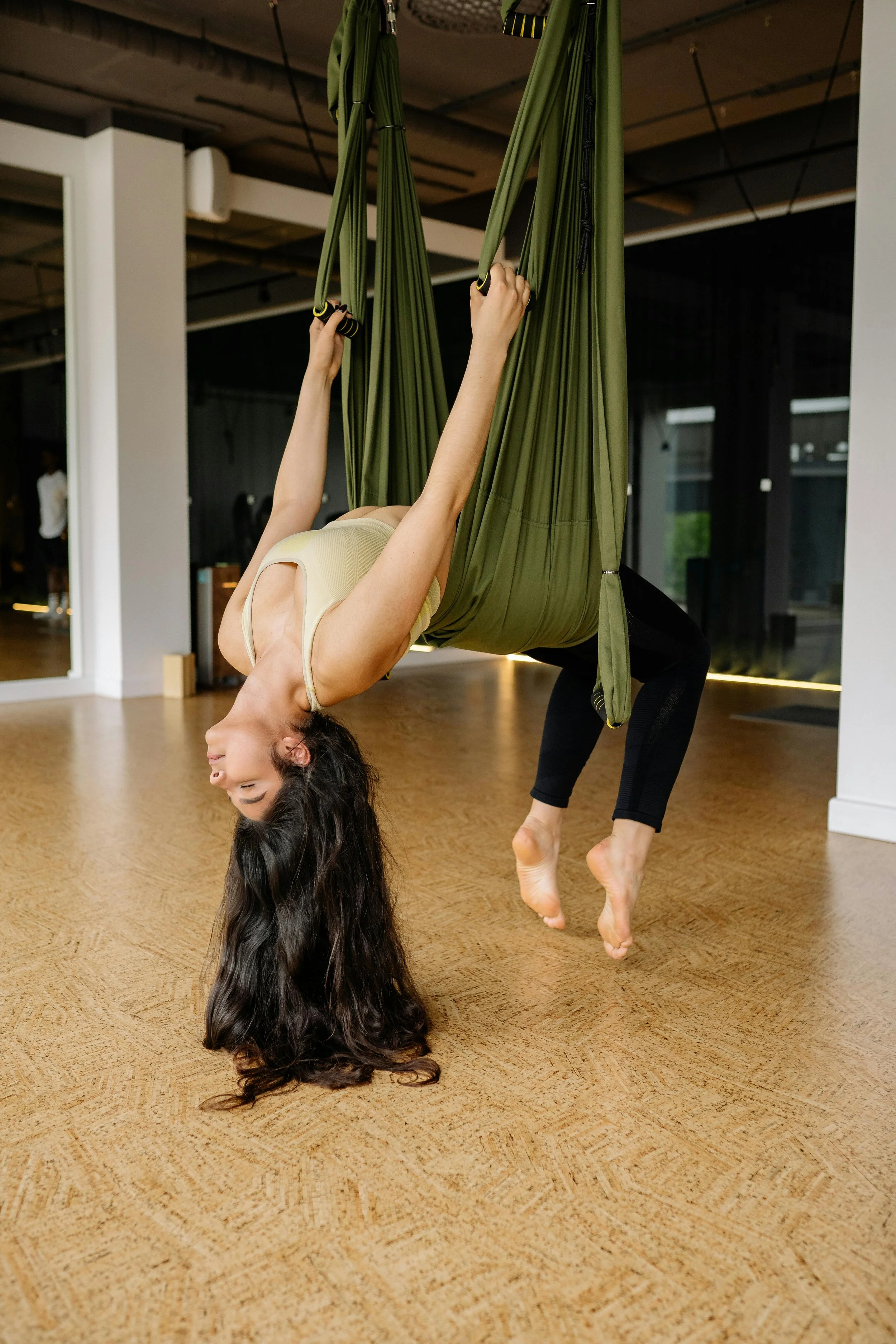The Science of Hanging Upside Down: How Inversions Improve Mood and Focus
The Science of Hanging Upside Down: How Inversions Improve Mood and Focus
By The Yoga Dance Co.
Let’s face it: hanging upside down feels a little rebellious, a little freeing, and, okay—maybe just a little weird (in the best way). Whether you’re flipping into an aerial hammock, kicking up into handstand, or folding into a good old-fashioned forward fold, inversions are more than just Instagram-worthy moments. They’re also surprisingly good for your brain, your mood, and your ability to focus when life feels chaotic.
So what’s actually happening when we flip the script and send our feet sky-high? Let’s dive into the science behind why turning your world upside down might just be the best thing for your mental clarity and emotional well-being.
What Counts as an Inversion?
First things first—what even is an inversion? In yoga and aerial practices, an inversion is any position where your heart is higher than your head. That means it’s not just about handstands or circus-level silks. Forward folds, downward dog, legs-up-the-wall (a fave, let’s be real), and even bridge pose all count.
And in aerial arts? Just hanging from your hips in a hammock or silks counts, too. You’re letting gravity do the work, decompressing your spine and literally giving your brain a fresh perspective.
The Brain on Inversions: More Oxygen, Please!
Your brain weighs about three pounds and uses a whopping 20% of the body’s oxygen. That’s right—your brain is basically a diva that demands VIP treatment. Inversions increase blood flow to the brain, delivering a rush of oxygen-rich blood. This oxygen boost can:
• Enhance mental clarity
• Improve concentration
• Support better memory and learning
Think of it as a brain spa. The increased circulation helps clear out brain fog, making you feel more alert and alive. It’s not magic—it’s just good ol’ anatomy and physiology doing its thing.
Mood-Boosting Chemistry, Unleashed
If you’ve ever left an aerial class or yoga session feeling totally euphoric, you’re not imagining it. Inversions activate your parasympathetic nervous system—aka the “rest and digest” system. This helps reduce cortisol (your body’s stress hormone) and signals your body to relax.
What does this mean?
• Lower anxiety
• Reduced symptoms of depression
• Improved emotional regulation
• That lovely post-class high
In some studies, inversions have been shown to increase levels of dopamine and serotonin—the “feel-good” chemicals in the brain. It’s like a natural antidepressant… just hanging around (literally).
Inversions and the Inner Ear (Balance & Focus)
Balance isn’t just about standing on one foot with your eyes closed. Your inner ear, specifically the vestibular system, plays a huge role in how you perceive movement and orientation in space.
Inversions stimulate this system, which helps:
• Improve spatial awareness
• Sharpen focus
• Enhance coordination
• Strengthen your body-mind connection
This is especially useful for dancers, aerialists, and anyone wanting to build stronger neurological pathways between movement and mental sharpness. Basically, the more you invert (safely!), the more your brain and body learn to talk better.
Lymphatic Drainage & Detox (Bye-Bye Brain Fog)
Inversions also support the lymphatic system—your body’s waste disposal network. Unlike the circulatory system, the lymph system doesn’t have a pump (like the heart) and relies on movement and gravity to work properly.
Flipping upside down helps lymphatic fluid move more efficiently, flushing out toxins and reducing inflammation.
Many aerialists say they feel lighter or refreshed after hanging, and this detox process might be one reason why.
Emotional Benefits: Getting a New Perspective (Literally)
Ever feel stuck in your head? Inversions offer a physical metaphor for a mental reset. Changing your physical orientation in space can often spark new ways of thinking and seeing challenges. It’s a little woo, sure, but it’s backed by psychology too.
Doing something out of the norm—like suspending yourself upside down in silks—creates novelty, which activates the brain’s learning centers and keeps the mind engaged.
Plus, it’s empowering. Nailing a new inversion move feels like a superpower. And that confidence bleeds into the rest of your life. Here at The Yoga Dance Co, we’re all about building confidence and having a positive mindset.
Are Inversions for Everyone?
Short answer: almost! But as with any practice, there are precautions. If you have high blood pressure, glaucoma, spinal injuries, or are pregnant, check with a medical professional before going full vampire-bat-mode.
But even gentle inversions—like supported bridge or legs-up-the-wall—can offer incredible benefits without flipping fully upside down.
Putting It into Practice: Inversions You Can Try Today
For yogis:
• Downward Dog
• Standing Forward Fold
• Headstand (against the wall if needed!)
• Shoulder Stand
• Legs-Up-The-Wall
For aerialists:
• Hip hangs in silks or hammock
• Inverted straddle
• Back straddle
• Footlocks and leg wraps leading into gentle inversions
Take it slow, warm up your body, and always prioritize alignment over ambition. Upside down isn’t a competition—it’s a celebration!
Final Thoughts: Flip It and Feel It
Inversions aren’t just cool tricks—they’re full-body resets that light up your brain, lift your spirits, and help you tap into deep states of presence. They remind us to play, to explore, and to literally change how we view the world.
Whether you’re dangling from a hammock or taking a few quiet breaths in downward dog, know that you’re giving your brain and body a beautiful gift: the gift of upside down magic.
Kids’ Corner: Why Hanging Upside Down Is Awesome!
Tyson Age 3
Little Warriors Class
Hey kids! Ever hang upside down from the monkey bars or do a somersault? Guess what? You were doing a mini inversion! Just like in yoga or aerial dance, going upside down helps your brain and body feel amazing.
Here’s why it’s so cool:
1. It Makes Your Brain Super Happy
When you hang upside down, more blood goes to your brain. That helps you think better, remember stuff, and feel more focused. It’s like giving your brain a bubble bath!
2. It Helps You Feel Calmer
Sometimes we feel mad, sad, or nervous. Going upside down helps calm our bodies down by turning on the “chill out” part of our brain. It’s kind of like giving your feelings a big cozy blanket.
3. It Helps You Balance Better
Hanging, spinning, or going upside down helps your inner ear, which tells your body where you are in space. That means you can balance better when you run, dance, or do gymnastics.
4. It’s FUN and Makes You Brave!
Trying new upside-down tricks takes courage. Every time you flip or hang, you’re training your brain to be more confident and your body to be stronger.
Try This at Home (With a Grown-Up Nearby):
• Legs up the wall
• Forward fold (bend down and touch your toes!)
• Hang like a bat from the couch (only if it’s safe!)
• Do an assisted cartwheel or handstand
So next time someone says, “Don’t be silly!”—you can say, “I’m actually boosting my brain with some serious upside-down science!”
Now you know: flipping upside down isn’t just fun—it’s smart, too. Happy hanging, little yogis! 🧘♀️✨
Want more playful wellness tips for the whole family? Visit us at The Yoga Dance Co. and come hang out—literally!






